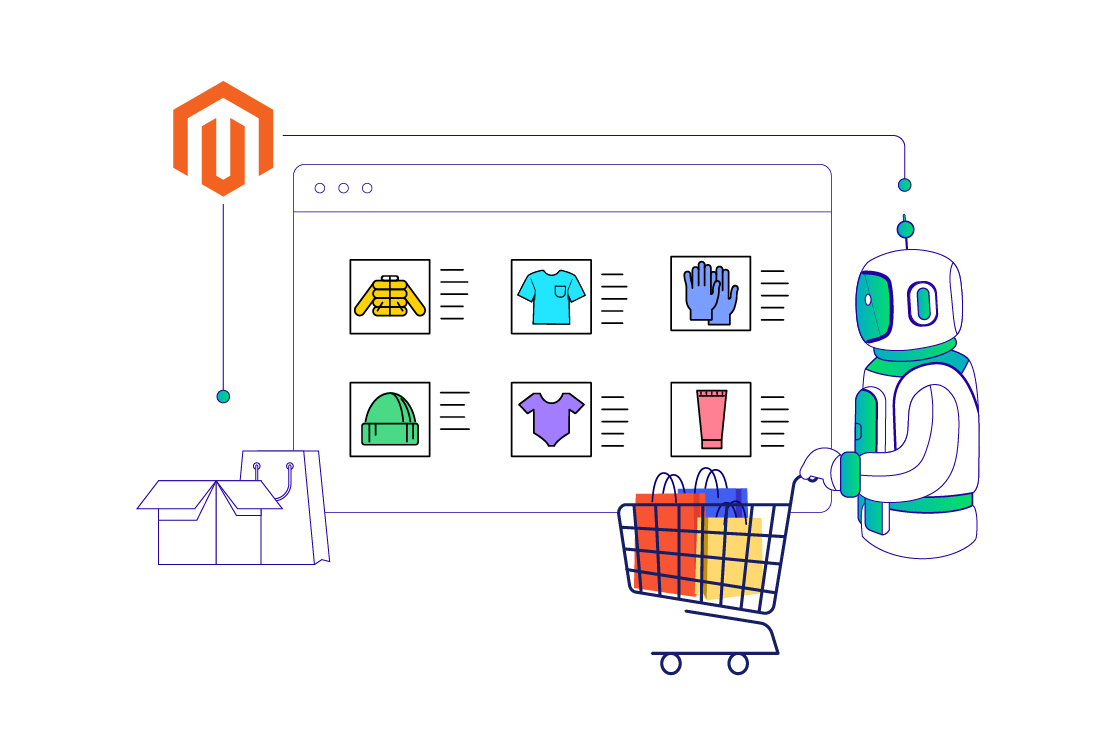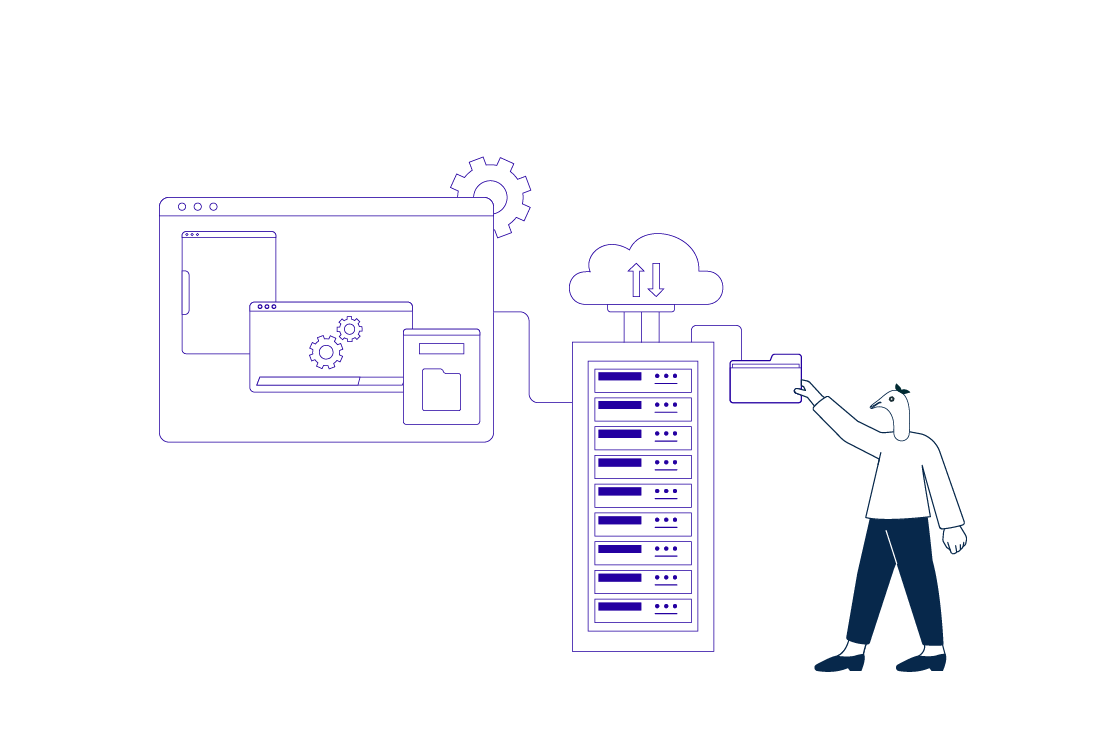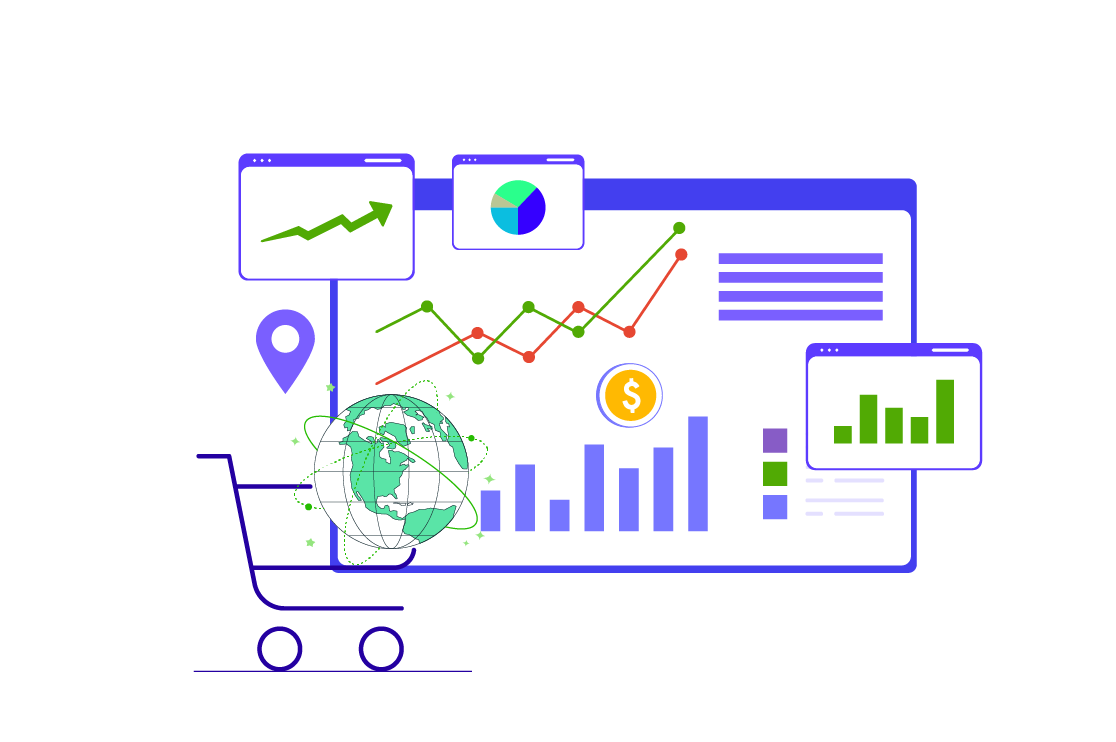In the present competitive eCommerce landscape, running an online store is no longer just about having a digital presence– it’s about significant revenue growth. Many businesses are stuck in a cycle of high traffic to low conversions and manual marketing efforts that are difficult to scale.
That’s AI-driven Magento stores change the eCommerce game.
By embedding Artificial Intelligence into your Magento operations, you transform your store from a simple sales channel into a revenue-generating engine. It cuts down operational waste by personalising the customer journey, syncing once and predicting buyer behaviour.
The AI edge gives CXOs the advantage of higher conversion rates, customer lifetime value and smarter business analytics.
Table of Contents:
- Is Your Magento Store Ready to Grow Beyond Itself?
- How Smart Brands Connect Magento Across Channels and Scale Smarter
- The Hidden Cost of Siloed Commerce
- Sync Once, Operate Everywhere: Making Multichannel Simple
- The Modern Edge: Predictive, Automated, Future-Ready Operations
- Quick Readiness Checklist for CXOs
- Your Roadmap to Smarter Omnichannel Growth
Is Your Magento Store Ready to Grow Beyond Itself?
Key Business Questions
Is your company still relying on generic product listings instead of personalized recommendations?
Is your marketing strategy reactive– not predictive?
Are manual workflows slowing down inventory, pricing, or promotions?
Are you missing insights into why customers abandon carts or drop off?
If you said Yes to any of the above, here are some things AI can do to solve these issues:
AI programs analyse customer behaviour to boost upsells and retention.
Predictive analytics can help forecast demand and optimize inventory. This adaptive AI means no more stockouts or overstocking.
Intelligent search and chatbots can reduce bounce rates and increase engagement.
Machine learning algorithms can automatically adjust pricing, promotions, and product visibility based on user intent and trends.
Why this matters to CXOs:
Aside from tackling the stated problems, AI integration is not just a tech upgrade– it’s a business growth strategy. AI gives a competitive and revenue-driven edge, meaning that your business will stay competitive in Magento.
Ignoring AI in Magento, however, would mean your business could have missed out on revenue, higher churn and increased underperforming marketing.
How Smart Brands Connect Magento Across Channels and Scale Smarter
Unified Customer View Across All Channels
With AI-powered Customer Relationship Management (CRM) and various analytics tools integrated into Magento, brands can centralize customer data from third-party stores, apps, social platforms and even in-store insights.
This way, CXOs will get a centralized, single source of truth for customer behaviour which is easier to manage and interpret. It enables smarter segmentation, targeted campaigns and increase Return On Investment (ROI) for marketing campaigns.
Real-Time Personalisation Across Touchpoints
Behavioural data analysed by AI engines can deliver experiences: from dynamic pricing and content provision to location-specific offers– customers can experience these whether they are on mobile, desktop or email.
Personalisation of the goods and services provided by the brand to the customer, drives conversion rates, reduces bounce and builds stronger loyalty.
Scalable Automation Across Ops, Marketing & Fulfilment
AI-driven tools like Enterprise Resource Planning (ERP), inventory forecasting and marketing automation enables businesses to scale operations without scaling overhead. By reducing manual dependencies and resources, lower operational costs and scale efficiently, CXOs can scale operations across regions with full control.
The Hidden Cost of Siloed Commerce
Fragmented Customer data means missed revenue
Sales, marketing, inventory and customer support data of a business live on different platforms– such as Magento store, CRM, ERP and email platforms. This can be tricky for a business to manage and understand data to make revenue-growth driven decisions.
AI programs can connect and analyse all the available data across siloes enabling dynamic pricing, personalised recommendations and impactful decision-making.
Manual Workloads Drive Up Operational Costs
Teams are being driven to manually update inventory, reconcile orders, run reports or categorise audiences across various siloes (or tools). This slows down the time-to-market, increases risk of human-error and drains resources that could have been allocated to critical strategizing.
Smart automation of order routing, product tagging and campaign delivery cuts overhead and accelerate operations.
Inaccurate Forecasting means Inventory & Budget Waste
Siloed data and decentralised demand data has caused inaccuracies in predictions leading to over-ordering or unprecedented stockouts. Inventory inefficiency and pileup eats into margins, while running out of stock hits customer trust and revenue gains.
Meanwhile, cross-channel forecasting allows teams to plan smarter and optimize working capital to attain desirable results.
Sync Once, Operate Everywhere: Making Multichannel Simple
The Problem: Disconnected Channels Drain ROI
Most Magento AI stores sync product information or orders across various channels, but manual syncs often break down. The risks of sync breakdowns are not the same as Operational Intelligence, as without real-time sync:
You risk inventory mismatches
Inconsistent customer experience
Slower order fulfilment and turnover
CXOs must consider: are your channels communicating effectively or just sharing static data with no meaningful insights?
The Solution: From Disorganised Syncing to Proactive Management
Now, smart brands are moving beyond just syncing SKUs– they manage pricing, inventory, fulfilment, promotions and return consistently across every channel.
With Magento AI automation, brands can auto-adjust pricing based on streamlined competitor and demand data. Through the C-Suite lens, how much time and resources are lost as your channels are not operating on the same logic?
In Practice: Smart Magento Brands using Syncing
DTC apparel brands sync smart Magento AI with marketplaces like Zalando, social commerce and in-store kiosks. Subsequently, AI analyses purchase behaviour per channel and auto-prioritizes identified inventory and fulfilment locations. Meanwhile, marketing and product recommendations shift depending on what’s trending for each region of interest.
The results are significant and tangible wherein a global fashion conglomerate using AI-powered supply chain decision intelligence saw a 275% increase in performance of its top 500 SKUs across 1,750+ stores during the holiday period.
So, for CXOs everywhere, you don’t just want data to exist– you want it to create business alignment logic across touchpoints of relevance. Sync once, operate everywhere means there is less rework for your employees, smart strategies while adaptive algorithms protect margins.
Recommended Reading:
- Generative AI Monetization: How Forward-Looking Executives Utilizing Data Smarter
- AI Data Analytics: The Road to Data Efficiency and Accuracy
- AI App Development with Snowflake
- GEN AI Strategy to Execution: Build Gen AI Powered Insights with Snowflake & AWS
- Role of AI Applications in Solving Business Problems Across Industries
- Your AI Is Only as Smart as Your Metadata
- Generative AI for Everyone: The No-Code Movement Powered by Snowflake
The Modern Edge: Predictive, Automated, Future-Ready Operations
Predictive Analysis that Anticipates Demand
While your Magento store collects thousands of data points daily: from customer behaviour to browsing patterns and purchases, AI powered predictive analytics can process this data to forecast what customers will want next. This is accomplished solely by analysing the customer’s observed tastes and preferences and then tailoring your brand’s marketing to appeal to the customer.
For example, a home decor brand can use predictive AI to identify seasonal spikes in demand for outdoor lighting and automatically promotes those items before their competitors can.
For CXOs this means that the brand gets the first mover-advantage in addition to reducing inventory waste and increasing sell-through rate. All of this– without straining resources and overburdening teams.
Dynamic Pricing & Merchandising
By analysing competitor pricing, popularity and customer behaviour, AI engines can automatically adjust product prices, discount and curate bundles to maximise conversion.
For instance, an electronics brand uses Magento AI to dynamically price accessories that are complementary to cart combinations and customer location. If a phone is added to cart, then a charger is strategically offered at 15% off rate– but only for repeat customers in high-value zip codes.
This way, brands can boost their order value and prevent margin leaks from price changes. CXOs are provided with an agile pricing engine that quickly analyse and adapt to market signals before competitors– thus providing a first-mover advantage.
Smart Supply Chain and Fulfilment
Beyond accepting an order, speed and accuracy in order fulfilment is often the make-or-break element for eCommerce. A smart fashion retailer would use AI to reroute orders from its East Coast warehouse to a central facility during snow days– preventing potential delays and reducing shipping costs to avoid customer dissatisfaction.
Further monetary benefits to the company include reduced last-mile costs, penalties, reduced manual sorting (causing human error). What does that mean for CXOs? It means more resilient and cost-efficient operations, customer centric decision-making and few logistic headaches.
Quick Readiness Checklist for CXOs: A Q&A
Is your customer data unified across all channels?If your Magento store, CRM, POS, and email platforms aren’t connected, your personalization and targeting efforts are missing the mark!
Can your team act on customer insights in real time?AI-driven triggers need fast, clean data pipelines development– not weekly reports.
Are you still relying on manual decisions for inventory, pricing, or promotions?AI-first brands use predictive analytics to automate stock replenishment, dynamic pricing, and campaign timing– allowing for reallocation of resources into more strategic decision making.
Is your Magento store integrated with marketing automation tools?Smooth integration allows AI to personalize offers, timing, and content– boosting ROI per customer touchpoint.
Do you have a clear view of ROI per channel or customer segment?Efficient AI systems step-in where revenue leaks or high-value opportunities exist– without confusing dashboards.
Is your tech team constantly firefighting instead of innovating?If your developers are stuck syncing systems manually, then you are not building efficient and smart infrastructure.
Have you piloted any AI-driven features like product recommendations or chat support?If not, then a simple pilot (e.g., AI chat, smart upsell widgets) can reveal huge untapped value. Following its success, further analytics and AI syncing programs should be integrated to achieve smart eCommerce operations.
Do your KPIs include metrics like customer lifetime value or cost per acquisition by segment?AI-first commerce isn’t just about traffic– it’s about maximizing margin per customer and reaping the benefits of return customers on profits.
Is your current Magento setup ready for multi-region scaling?Existing fragmented systems slow down expansion, while centralised systems and dashboards by AI thrives on centralized, scalable architecture.
Are you getting proactive insights– or just stagnant reports?The best AI setups predict and give suggestions based on what your customers or business will benefit the most from.
Recommended Reading:
- How to Sync Magento Store with Other B2C Ecommerce Platforms
- 10 Best Magento Extensions to Boost Sales and Enhance ecommerce Performance
- Magento ecommerce: Ticket to Big ecommerce Sales
- Why is Magento eCommerce Development Best for Your Retail Business?
- What are the Pros and Cons of Magento Website Development?
- Magento vs Shopify: The Battle of the eCommerce Titans
Your Roadmap to Smarter Omnichannel Growth
This section is designed specifically to offer CXOs a starting point to integrate smart frameworks into their brand’s eCommerce.
Step 1: Assess the existing framework
Identify the platforms your Magneto store is connected to (i.e. CRM, inventory system, marketing).
Determine the team reliance on manual updating or syncing.
A quick audit by BluEnt can identify data siloes and gaps in integration.
Step 2: Define KPIs that matter
Aside from tracking data traffic, understand the conversion rate, average order value and customer retention.
Then, set achievable goals and targets from these data insights.
Business intelligence dashboards in AWS QuickSight help you define and monitor these metrics in real time
Step 3: Ask the vendors the right questions
Smart vendors can help answer questions from:
How does the solution provide scale with the business?
What level of personalisation is possible?
How is the AI trained and what is the accuracy level?
Step 4: Start with use cases that show immediate improvement
Dynamic pricing based on customer demand
AI-driven bundling
Predictive analysis for churn
BluEnt can implement these models into your Magento AI business to achieve your KPI goals and targets.
Step 5: Implement in batches– not all at once
Prioritize one or two channels (e.g. email and phone) that have been identified by data analysis.
Rollout AI-driven solution on those platforms then tests personalisation.
Optimise AI on these platforms then expand on remaining platforms
Step 6: Review and Optimise Regularly
Establish centralised dashboards that monitor performance on metrics of review attribution, engagement and revenue per campaign.
Use Alpha and Beta testing to refine offer strategies (powered by AI).
Analytics and reporting cycles help you progressing towards smarter omnichannel growth.
Key Conclusion and Analysis
The ecommerce development market is experiencing robust growth, driven by several key factors including increase in smartphone & internet penetration and evolving customer experience in online shopping. Thus, the demand for an AI-driven Magento ecommerce platform should not be considered just as any random upgrade. It is the growth multiplier for the businesses.
By unifying data, automating decisions, and predicting customer behaviour, CXOs can transform Magento from a basic storefront into a future-ready revenue engine. The choice is clear: either continue fighting with siloed operations, or step into an AI-powered commerce model that scales smarter, sells faster, and keeps customers loyal.












 Sync Magento Store with Other B2C Ecommerce Platforms: A Guide to Multichannel Integration
Sync Magento Store with Other B2C Ecommerce Platforms: A Guide to Multichannel Integration  MACH Architecture for Unified Global Multi-Store Ecommerce: The Future of Headless Commerce
MACH Architecture for Unified Global Multi-Store Ecommerce: The Future of Headless Commerce  Setting Up Global Ecommerce Stores Without Duplicating Infrastructure
Setting Up Global Ecommerce Stores Without Duplicating Infrastructure  E-commerce Checkout Funnel: Why 60% of Your Customers Are Disappearing and What to Do About It
E-commerce Checkout Funnel: Why 60% of Your Customers Are Disappearing and What to Do About It 
